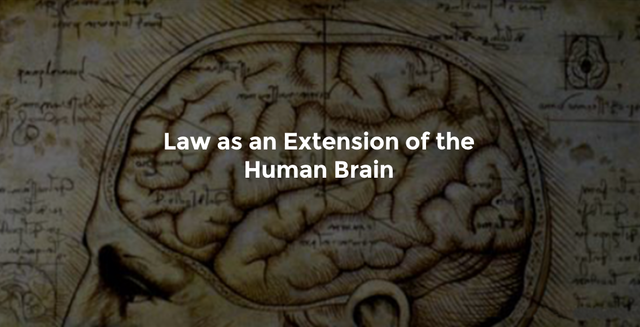
During the mechanical ages we had extended our bodies in space. Today, after more than a century of electric technology, we have extended our central nervous system itself in a global embrace, abolishing both space and time as far as our planet is concerned. Rapidly, we approach the final phase of the extensions of man — the technological simulation of consciousness, when the creative process will be collectively and corporately extended to the whole of human society, much as we have already extended our senses and our nerves by the various media (McLuhan, 1966, p. 19).
McLuhan used two broad classes of extensions of the organism: extensions of the body and extensions of cognitive functions. I’ve added a third category: extensions of social functions.
“Industrial tools extend our muscles, digital tools extend our minds, and law as a tool extends the ways in which we can organize as a society. “ (Nygren, 2016)
Eusociality and the evolution of legal systems
Human behavior is a product of both internal and external mediation. We evolved as social creatures, and our brains are adept at writing rules that mediate how we operate together. Our ability to write laws, and to replicate those laws, is very much what it means to be human, and the basis for how cultures evolve.
The legal systems we create inform and mediate the way we behave, in constant feedback with our internal laws. There is a seamless continuity between internal mediation and external mediation, the two work together, and this duality is what it means to be human, we are social creatures, both individuals and collectives at the same time.
Coercive laws and voluntary laws
Law can be divided into two types of law: voluntary law, and coercive law. Voluntary law is when a law is agreed upon, because it makes life simpler for all parties involved, and is something desirable. Coercive law is when a law is forced upon someone who has not agreed to the law. (1)
In coercive law, genetic imperatives dominate, while in voluntary law, memetic imperatives are the dominant enforcement. Dominance for example is a genetic imperative which works through the serotonin system to regulate social status, where decreased social status leads to anhedonia and absence of reward.
Internal mediation meets legal mediation
The word legal derives from loyal, and the human brain is designed to select laws that are loyal to the self, not to the super-organism of the state. Voluntary law easily integrates with the internal state of an individual, and the two work together to extend the capacity of the individual. Coercive law does not integrate at all with inner mediation, and is instead constantly fought off the way a body would reject an implant.
Law as a mediating system
Law could be defined as a technological extension of the human brain’s ability to co-ordinate and form organization with other brains. Industrial tools extend our muscles, digital tools extend our minds, and law as a tool extends the ways in which we can organize as a society.
Laws facilitate package transport of memes, and co-ordinates action across multiple brains. (2) The human brain has a memory limit known as dunbar’s number, pre-technology meme pools do not scale beyond 150 individuals. Technology like writing, currency and legal code, religions, made it possible to co-ordinate at scales beyond dunbar’s number. (3)
Memes co-opt genetic imperatives such as food, sex, territory and dominance, and form the basis of a priori prejudice or predispositions that we call cultural traits. Sense of right and wrong, how justice should be carried out — all these are programmed through meme-replication.
Laws co-ordinate action through attention networks. They tap into genetic imperatives such as territory, or fear, which then direct attention to the memeplex which codes for the law, and amplifies its action, and its effect on other resident memes. (2)
Laws are protocols that govern the spread of memes, and the infusion of memes into brains. Moral law as a protocol is enforced through fear using threat of violence.
Laws are shared mediation
Laws are memes which colonize the mind of groups of brains, and elicit action. They do so through hijacking resident memes, which in turn co-opt genetic imperatives.
Laws only work on brains which are pre-configured for them.
Laws connect networks of brains into larger organization.
Moral Law because Cheaper
A rule of thumb that I've used is that legal machinery is expensive, and so, we have used moral law because it has been too expensive to build a universal private law infrastructure.
Nina Gunther Kilbride talks about how the web 3.0, the "legal web" what could also be called "incentive networks" (4) enables global access to private law which has previously been limited to the rich because of the high costs of maintaining a pre-crypto private law infrastructure.
"Done well, smart contracts will unlock for everyday users the wonders of private law previously only available to the rich. "
- Nina Kilbride
This will massively improve social organization, using "Social Technology" as Zachary Caceres calls it.
Incentives, genetic and memetic imperatives
Examples of genetic imperatives are food, sex, dominance, territory.
Examples of memetic imperatives are intelligence and knowledge and creativity and art and experience and novelty and technology.
Upgrading law to run on memetic imperatives
See Note on basic income and hyper-intelligence
Law which runs on memetic imperatives does not scale using human-based trust-systems (5), because validators were required to uphold the law, and they would have to sacrifice their memetic imperatives in favor of the social order, leading to top-down control through neurosis, working through genetic imperatives such as dominance and thereby inhibiting self-actualization.
With the advent of technology-based trust-systems, there are enough resources for a legal system which runs on memetic imperatives. (6)
References:
Law, Memes and Mental Illness: Towards Ideation Without Coercion - Bitnation.co, 2016
http://reset.me/user_news/law-memes-and-mental-illness-towards-ideation-without-coercion/
Genes, Memes, Culture and Mental Illness: Towards an Integrative Model - The Journal of Clinical Psychiatry, 2011
http://psychiatrist.com/JCP/article/Pages/2011/v72n12/v72n1223.aspx
Robin I.M. Dunbar (1998), The Social Brain Hypothesis
http://kreativproces.dk/http:/kreativproces.dk/wp-content/uploads/2010/08/Dunbars-tal-og-reseach.pdf
From Social Networks (Web 2.0) to Incentive Networks (Web 3.0) - Medium.com, 2016
https://medium.com/@maciejolpinski/why-i-no-longer-explain-ethereum-as-a-world-computer-5adf7220b3eb
The four pillars of a decentralized society | Johann Gevers | TEDxZug
http://tedxtalks.ted.com/video/The-Four-Pillars-of-a-Decentral
Decentralized Law on the Ethereum State-machine
https://steemit.com/ethereum/@johan-nygren/decentralized-law-on-the-ethereum-state-machine
Simon Deakin (2002), Evolution for Our Time: A Theory of Legal Memetics
http://clp.oxfordjournals.org/content/55/1/1.extract#
Michael Freeman (2009), Law, Mind and Brain
https://www.amazon.com/Law-Mind-Brain-Medical-Ethics/dp/0754670139
Nick Szabo (1997), Formalizing and Securing Relationships on Public Networks
http://szabo.best.vwh.net/formalize.html
Ramesh Subramanian (2009), The Global Flow of Information: Legal, Social, and Cultural Perspectives
http://isp.yale.edu/global-flow-information-legal-social-and-cultural-perspectives
Dana Edwards (2016), Thinking Outside the Brain – Why We Need to Build a Decentralized Exocortex
https://magazine.backfeed.cc/thinking-outside-brain-need-build-decentralized-exocortex/
Dana Edwards (2016), Incentive Design Patterns and Stigmergic Optimization
https://steemit.com/steemit/@dana-edwards/incentive-design-patterns-and-stigmergic-optimization
Honorable mentions
Hoyle Leigh, psychiatrist and MD, co-created the Yale Behavioral Medicine Clinic with Gary Schwartz. Wrote the seminal work Genes, Memes, Culture and Mental Illness: Towards an Integrative Model (2010)
Nina Kilbride, lawyer and smart contract developer, Head of Legal Engineering at Eris Industries
Zachary Caceres, authentic, inspiring, creative speaker, storyteller and artist, Voice and Exit. Popularizing and furthering the concept of Social Technology

Laws exist to defend rights. Defense of rights is the purpose of governments. I prefer not to use the word "law" at this time for what we have with blockchains and smart contracts. On blockchains we have rules, but not laws, because laws have to be enforced, and laws exist within a paradigm.
If we have an agreement on the human rights we wish to protect, or digital rights for natural persons and for electronic persons, and if the system is designed in a way to take continuous feedback from participants, and it's all voluntary, then yes, you can have dispute resolution, voluntary law is possible if the system can interface with law enforcement. On a blockchain, you have reputation as the main currency, and this is where accountability is at and how rules get enforced.
If a person pledges to a set of rules or "laws", then reputation is based on adherence to the rules or "laws" they pledged to. It's discussed a bit in polystate. A polystate basically is the atmosphere we can have in virtual space, where people choose their rules, but we must be careful with this.
With pseudo-anonymity you always have the ability to avoid coercion. When pseudo-anonymity is lost, coercion becomes possible or even likely, which is why I promote pseudo-anonymity so much on Steemit. When you have reputation and a blockchain which never forgets anything, then it's not like a small town. A small town eventually forgives and forgets.
Downvoting a post can decrease pending rewards and make it less visible. Common reasons:
Submit